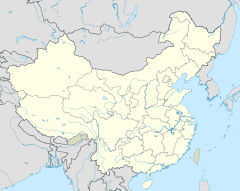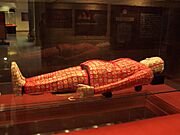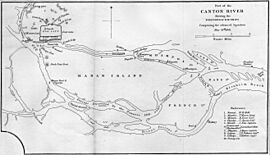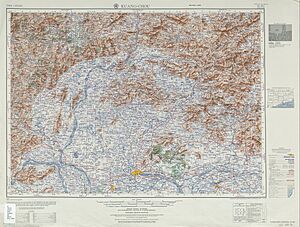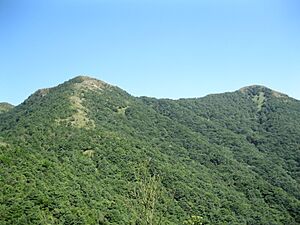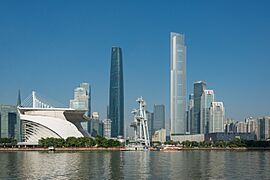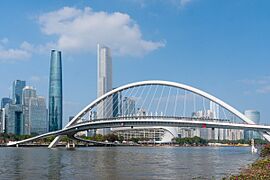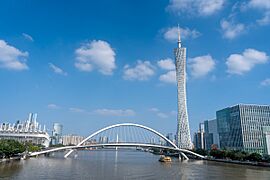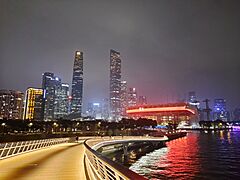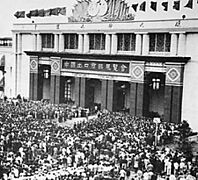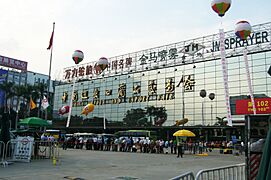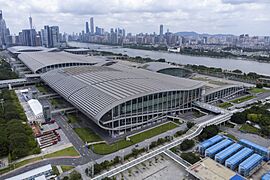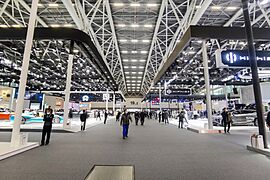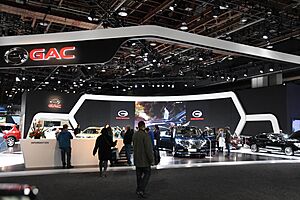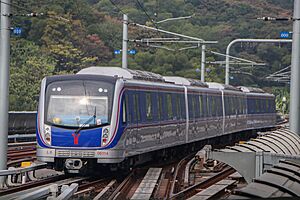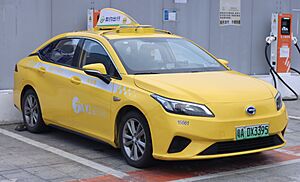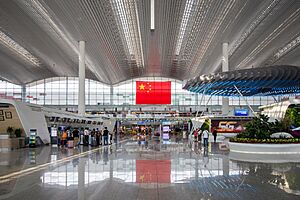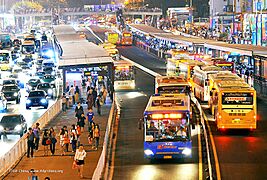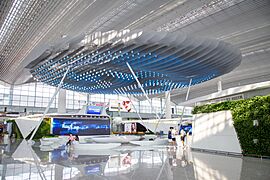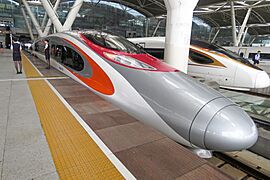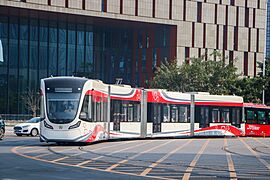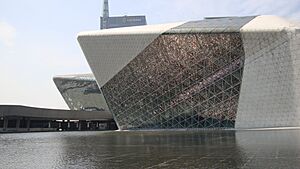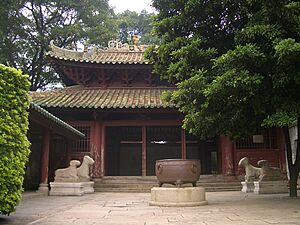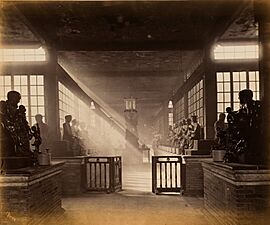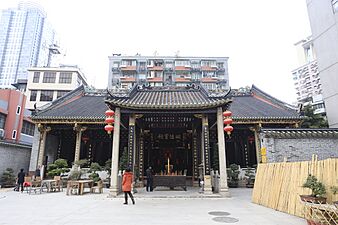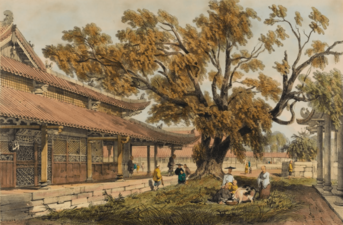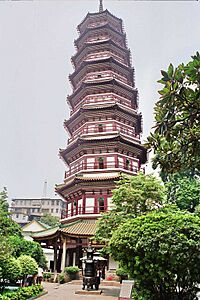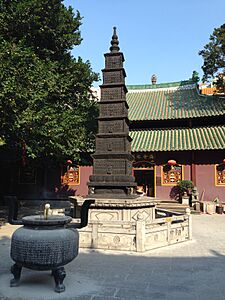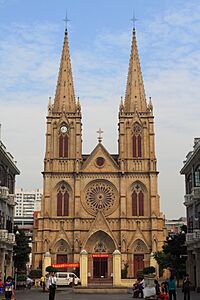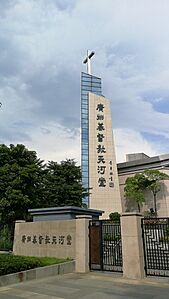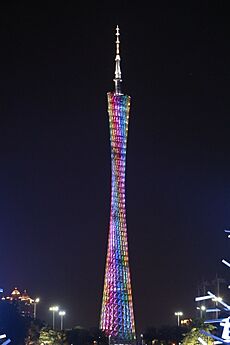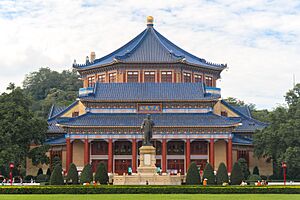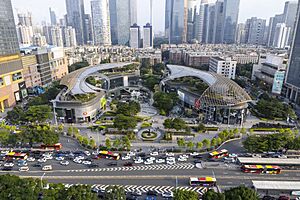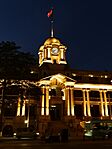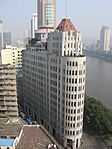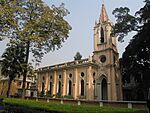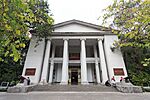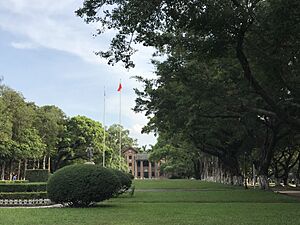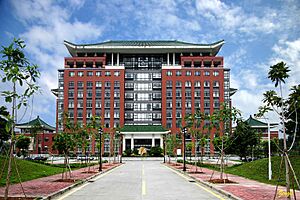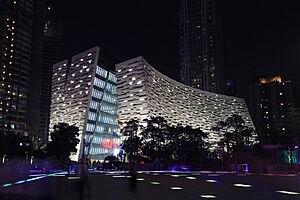Guangzhou facts for kids
Quick facts for kids
Guangzhou
广州市
Canton; Kwangchow
|
|
|---|---|
|
Prefecture-level and sub-provincial city
|
|
|
Canton Tower in front of the Pearl River
Guangzhou Library
Canton Fair Complex
Liurong Temple
Five-Ram Sculpture
Sacred Heart Cathedral
Zhenhai Tower
Sun Yat-sen Memorial Hall
|
|
| Nicknames:
City of Rams, City of Flowers, City of Rice Spike
|
|
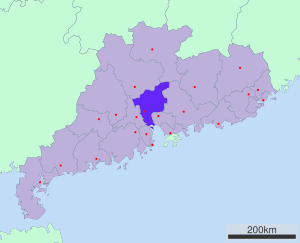
Location of Guangzhou City jurisdiction in Guangdong
|
|
| Country | China |
| Province | Guangdong |
| Settled | 214 BC |
| Founded by | Qin dynasty |
| Municipal seat | Yuexiu District |
| Government | |
| • Type | Sub-provincial city |
| • Body | Guangzhou Municipal People's Congress |
| Area | |
| • Prefecture-level and sub-provincial city | 7,434.4 km2 (2,870.4 sq mi) |
| • Urban | 2,256.4 km2 (871.2 sq mi) |
| • Metro | 20,144.1 km2 (7,777.7 sq mi) |
| Elevation | 21 m (69 ft) |
| Population
(2020 census)
|
|
| • Prefecture-level and sub-provincial city | 18,676,605 |
| • Density | 2,512.187/km2 (6,506.54/sq mi) |
| • Urban | 26,940,000 |
| • Urban density | 11,939.4/km2 (30,923/sq mi) |
| • Metro | 32,623,413 |
| • Metro density | 1,619.502/km2 (4,194.491/sq mi) |
| Demonym(s) | Cantonese |
| GDP | |
| • Prefecture-level and sub-provincial city | |
| • Per capita |
|
| Time zone | UTC+08:00 (China Standard Time) |
| Postal code |
510000
|
| Area code(s) | (0)20 |
| ISO 3166 code | CN-GD-01 |
| License plate prefixes | 粤A |
| City Flower | Bombax ceiba |
| City Bird | Chinese hwamei |
| Languages | Cantonese, Standard Chinese |
| Guangzhou | |||||||||||||||||||||||||||
|---|---|---|---|---|---|---|---|---|---|---|---|---|---|---|---|---|---|---|---|---|---|---|---|---|---|---|---|

"Guangzhou" in Simplified (top) and Traditional (bottom) Chinese characters
|
|||||||||||||||||||||||||||
| abbreviation | |||||||||||||||||||||||||||
| Chinese | 穗 | ||||||||||||||||||||||||||
| Hanyu Pinyin | Suì | ||||||||||||||||||||||||||
| Cantonese Yale | Seuih | ||||||||||||||||||||||||||
|
|||||||||||||||||||||||||||
Guangzhou, also known as Canton or Kwangchow, is a very important city in southern China. It is the capital and largest city of the Guangdong province. Guangzhou is located on the Pearl River, about 120 kilometers (75 miles) north of Hong Kong and 145 kilometers (90 miles) north of Macau. This city has a long history, stretching back over 2,200 years. It was once a major stop on the ancient Silk Road, a famous trade route.
The port of Guangzhou is a huge transportation center. For a long time, it was the only Chinese port where most foreign traders could do business. Even after other ports like Hong Kong and Shanghai opened, Guangzhou remained a very important trading hub. Because it has so many people and a busy port, Guangzhou is known as a "Large-Port Megacity," one of the biggest port cities in the world.
Guangzhou is at the center of the Guangdong–Hong Kong–Macau Greater Bay Area. This is the most populated urban area in the world, with about 70 million people! It includes nearby cities like Foshan, Dongguan, and Shenzhen. Guangzhou is also one of China's nine "National Central Cities," which means it's a very important city for the country. Many people from other parts of China have moved to Guangzhou for work. In 2020, the city's population was over 18.6 million.
Guangzhou is famous for its yearly Canton Fair, which is China's oldest and largest trade show. For several years, Forbes magazine even called Guangzhou the best city for business in mainland China. It's also a major financial center in Asia and has hosted big sports events like the 2010 Asian Games. Many countries have their offices (consulates) in Guangzhou, making it a key international city. The city is also a big center for science and research, with many top universities.
Contents
- What's in a Name? Understanding Guangzhou's Names
- A Journey Through Time: Guangzhou's History
- Geography: Where is Guangzhou?
- Administrative Divisions: How Guangzhou is Organized
- Economy: Guangzhou's Business and Trade
- Demographics: Who Lives in Guangzhou?
- Transportation: Getting Around Guangzhou
- Culture: The Heart of Cantonese Traditions
- Sports: Guangzhou's Athletic Side
- Destinations: Places to See in Guangzhou
- Media: News and Entertainment
- Education and Research: Learning in Guangzhou
- Notable People from Guangzhou
- International Relations: Guangzhou's Global Connections
- See also
What's in a Name? Understanding Guangzhou's Names
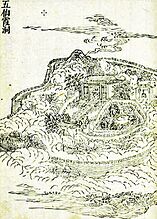
The official name, Guǎngzhōu, comes from an old area called Guang Prefecture. The Chinese word 广 means 'broad' or 'expansive'.
Before its current name, the city was called Panyu. This name is still used for one of Guangzhou's districts today. The city was also sometimes called Guangzhou Fu, which meant it was the capital of a large area.
Guangzhou has many nicknames! Its Chinese abbreviation is 穗, which means 'rice spike'. This is why it's also called the "City of Rice." It's also known as the "City of Rams" or "City of the Five Rams." This comes from a legend about five heroes who rode rams and brought rice farming to the area. Another nickname is the "City of Flowers," because of its beautiful plants and greenery.
The English name "Canton" came from the Portuguese word Cidade de Cantão. This name was used for a long time, and you can still hear "Cantonese" when talking about the people, language, food, and culture of Guangzhou and the surrounding area.
A Journey Through Time: Guangzhou's History
Early Settlements and the Nanyue Kingdom
People lived in the Guangzhou area as early as 1100 BC. The city, then called Panyu, was officially founded in 214 BC. It was a base for the Qin Empire's army when they explored southern China.
After the Qin dynasty fell, a general named Zhao Tuo created his own kingdom called Nanyue in 204 BC. Panyu became its capital. This kingdom was independent for many years. Archeologists have found items from Southeast Asia, India, and even Africa in Panyu, showing it was a busy trading center.
Imperial China: Trade and Challenges
In AD 226, Panyu became the capital of Guang Prefecture, which is how it got its modern name. Guangzhou was a very important port in southern China. Ships from the Middle East and other places came here to trade.
However, there were also difficult times. In 758, Arab and Persian pirates attacked the city. Later, in 878, a Chinese rebel leader caused a massacre, killing many foreign traders. The port was closed for 50 years after this event.
During the 10th to 12th centuries, Guangzhou was a thriving city. A traveler named Odoric of Pordenone said it was as big as three Venices and made as many crafts as all of Italy! Another famous traveler, Ibn Battuta, visited in the 14th century and described how the Chinese built their large ships.
Later, the Ming dynasty limited foreign trade. But in the 16th century, Portuguese traders arrived. After some conflicts, they were allowed to trade in Macau, near Guangzhou. By the 18th century, Guangzhou became one of the world's biggest ports, known for exporting tea and porcelain. This trade helped connect China with the rest of the world.
In the 19th century, Guangzhou was a bustling city with narrow streets and many small buildings. The city walls were strong and guarded. The Pearl River was filled with boats of traders and fishers. Messages could even be sent to Beijing, over 1,200 miles away, in less than 24 hours!
The special trading system in Guangzhou ended with the First Opium War in 1839. British forces captured the city in 1841. After the war, more ports opened in China, and Guangzhou lost its special trading status. Much of the international trade moved to Shanghai.
Modern China: Revolutions and Growth
Guangzhou played a big role in the revolutions that led to the end of the Qing dynasty. Many revolutionaries were honored as martyrs in the city.
From 1923 to 1926, Sun Yat-sen and the Kuomintang (KMT) party used Guangzhou as a base to try and unite China. They built their own army and trained soldiers. This period was very important for the KMT's future rule in China.
During WW2, Guangzhou was occupied by the Japanese army in 1938. After the war, in 1949, the Communist Party took control of Guangzhou. Many people moved to Hong Kong and Macau during this time.
Since the 1980s, Guangzhou has grown rapidly. Its location near Hong Kong and Shenzhen, and its connections to Chinese people living abroad, helped it become one of the first cities to benefit from China's "opening up" policy. The city has continued to expand, adding new districts and growing its economy. In 2022, an EF2 tornado hit the city, causing power outages.
Geography: Where is Guangzhou?
Guangzhou is located on the east bank of the Pearl River, about 80 miles from the South China Sea. The city sits on a rich plain called the Pearl River Delta. The Pearl River is the fourth-largest river in China.
The city's land rises from southwest to northeast, with mountains in the north and the ocean to the south. Tiantang Peak is the highest point in Guangzhou, standing at 1,210 meters (3,970 feet) above sea level.
Natural Resources: What Does Guangzhou Have?
Guangzhou has many natural resources. There are 47 different types of minerals, including granite, limestone, and mineral water. The city also has a lot of water, with many rivers and waterways making up 10% of its total land area.
Water Resources
Guangzhou has a lot of water from rivers that flow through it, like the Beijiang and Dongjiang rivers. These rivers join the Pearl River and flow into the sea. While the city has some local water, most of its water comes from these larger rivers passing through. The Pearl River's three main entrances bring in a huge amount of water each year, which helps keep the city's environment stable.
Biological Resources
Guangzhou is rich in plant life, especially fruit trees. It's a major area for fruits like lychee and longan. The city also grows many high-quality vegetables. Flowers are a big part of Guangzhou's culture, with over 3,000 types grown for decoration, medicine, and other uses. There are also many types of grains, crops, livestock, and aquatic products.
Mineral Resources
Guangzhou has a complex geological structure, which means it has many different minerals. Forty-seven types of minerals have been found, including granite for building, limestone for cement, and ceramic clay. However, the city has less energy minerals and non-ferrous metals.
Climate: What's the Weather Like?
Guangzhou has a humid subtropical climate. This means it has wet summers with high temperatures and humidity. Winters are mild and dry. The city experiences a long monsoon season from April to September, bringing a lot of rain.
The average temperature is about 22.4°C (72.3°F) for the year. Autumn, from October to December, is usually the best time to visit because the weather is cool and breezy. Guangzhou gets over 1,950 millimeters (77 inches) of rain each year. The city doesn't get a lot of sunshine compared to nearby cities. The lowest temperature ever recorded was 0°C (32°F) in 1957 and 1999. The last time it snowed in Guangzhou was on January 24, 2016.
Administrative Divisions: How Guangzhou is Organized
Guangzhou is a special type of city called a sub-provincial city. It is divided into eleven smaller areas called districts.

Liwan
Yuexiu
Haizhu
Tianhe
Baiyun
Huangpu
Panyu
Huadu
Nansha
Conghua
Zengcheng
|
|
||||||||||||||||||||||||||||||||||||||||||||||||||||||||||||||||||||||||||||||||||||||||||||||||||||||||||||||||||||||||||||||||||||||||||||||||
|
|||||||||||||||||||||||||||||||||||||||||||||||||||||||||||||||||||||||||||||||||||||||||||||||||||||||||||||||||||||||||||||||||||||||||||||||||
Economy: Guangzhou's Business and Trade
Guangzhou is a major center for manufacturing and business in China. In 2021, its economy was one of the largest in the region. Guangzhou is considered one of the most successful cities in China. Many rich people live here, and it's expected to be one of the world's top 10 cities for economy by 2035. It's also a big financial hub in Asia.
Because of its fast growth, Guangzhou was once quite polluted. But now, with better city planning, it's considered one of the most livable cities in China.
Zhujiang New Town: The Modern Business Hub
Zhujiang New Town is Guangzhou's main business district today. It's located in the Tianhe District and is home to many important financial companies.
-
Haixin Bridge and Canton Tower near Zhujiang New Town
Canton Fair: China's Biggest Trade Show
The Canton Fair is a huge trade show held every April and October. It started in 1957 and is the oldest and largest trade fair in China. It's a very important event for the city's economy. The fair now takes place at the Guangzhou International Convention and Exhibition Center in Pazhou.
Local Products: What Guangzhou is Famous For
- Cantonese cuisine is one of China's most famous food styles. People often say, "Eat in Guangzhou!"
- Cantonese sculpture includes beautiful works made from jade and wood.
- Canton porcelain is a colorful style of pottery that was made for export.
- Cantonese embroidery is one of China's four main styles of embroidery.
- Zhujiang Beer is a very popular beer brand in China.
Major Industries and Business Environment
Guangzhou is home to many important companies and industrial zones.
- GAC Group is a big car manufacturer.
- The Guangzhou Economic and Technological Development Zone and Export Processing Zone attract many businesses.
- The Guangzhou Free Trade Zone is a special area for international trade and logistics.
- Guangzhou Science City is a hub for research and technology.
Guangzhou is a popular place for international businesses. By 2018, over 30,000 foreign companies had set up in Guangzhou. This includes many of the world's largest companies.
Demographics: Who Lives in Guangzhou?
In 2010, Guangzhou's population was about 12.78 million people. By 2014, it was estimated to be over 13 million. The city is part of a huge urban area with over 28 million people, including Hong Kong. Many people move to Guangzhou for work, creating a large "floating population."
Ethnicity and Language: Cantonese and More
Most people in Guangzhou are Han Chinese. Almost all local people speak Cantonese as their first language. Many people who move to Guangzhou from other parts of China speak Mandarin. In 2010, about half the city spoke Cantonese and half spoke Mandarin.
Younger people in Guangzhou are starting to use more Mandarin. However, there are efforts to keep the Cantonese language and culture alive. Many families are encouraging their children to speak Cantonese. Studies show that about 90% of people in Guangzhou can speak both Cantonese and Mandarin.
Guangzhou also has a large population of Hakka people, especially in districts like Zengcheng and Huadu. Their culture and language are also important parts of Guangzhou.
The city has a large number of people who have moved from other parts of China. This is because of Guangzhou's fast-growing economy and the need for workers. Guangzhou also has many foreign visitors, workers, and residents, including a notable community of African immigrants.
Transportation: Getting Around Guangzhou
Urban Mass Transit: Metro and Buses
The Guangzhou Metro opened in 1997, making Guangzhou one of the first cities in mainland China to have an underground train system. Today, the metro has sixteen lines and covers over 650 kilometers (400 miles). There are plans to expand it even more. There is also a tram line called the Haizhu Tram.
The Guangzhou Bus Rapid Transit (GBRT) system started in 2010. It's the second-largest bus rapid transit system in the world, carrying over 1 million passengers every day! Buses come very often, sometimes every 10 seconds during busy times.
Motor Transport: Cars and Taxis
In the early 1900s, Guangzhou began tearing down its old city walls to build wider streets for cars and trams. By 2010, almost all buses and taxis in Guangzhou were using LPG fuel. This helps keep the air cleaner. Guangzhou uses more LPG-fueled vehicles than any other city in the world.
Since 2007, motorcycles have been banned in Guangzhou's urban areas to help with traffic and safety.
Airports: Connecting Guangzhou to the World
Guangzhou's main airport is Baiyun International Airport. It opened in 2004 and is one of the busiest airports in China. It has three runways, with plans for more. A second terminal opened in 2018. You can also take ferries or buses from Guangzhou to Hong Kong International Airport.
Rail: Trains to Other Cities
Guangzhou is a major train hub. High-speed trains connect Guangzhou to cities like Wuhan and Guiyang. The Guangdong Through Train goes from Guangzhou to Hong Kong in less than two hours. There are also regional trains that connect Guangzhou to nearby cities like Foshan and Zhuhai.
Water Transport: Ferries and Boats
You can take high-speed ferry services from Guangzhou to Hong Kong and Macau. These ferries depart from Nansha Ferry Terminal and Lianhua Shan Ferry Terminal.
- Transport in Guangzhou
-
Panyu Square station of the Guangzhou Metro
-
Trains used by the Guangzhou Metro
Culture: The Heart of Cantonese Traditions
Guangzhou's culture is mainly Cantonese culture. This is a part of the larger "Lingnan" culture of southern China. Important parts of Cantonese culture include:
- Cantonese language: The local language spoken in Guangzhou.
- Cantonese cuisine: One of China's eight main food traditions.
- Cantonese opera: A traditional Chinese opera style.
The Guangzhou Opera House and Guangzhou Symphony Orchestra perform classical music. Cantonese music is a traditional style, while Cantopop is the local pop music, similar to what you hear in Hong Kong.
It's important to remember that Cantonese language, food, and opera are shared across the whole Guangdong region, not just in Guangzhou. Guangzhou also has other cultures, like Hakka culture, because many different people live there. In areas with Hakka people, their culture is well-preserved.
Religions: Faith in Guangzhou
Guangzhou has many different religions.
- Taoism and Chinese folk religion are practiced in some temples. The Temple of the Five Immortals is very important. It's dedicated to five heroes who brought rice farming to the city.
- Buddhism is the most common religion in Guangzhou. Famous temples include the Guangxiao Temple and the Temple of the Six Banyan Trees. These temples have been rebuilt after being damaged in the past.
- Christianity has a long history in Guangzhou. The Sacred Heart Cathedral of Guangzhou is a beautiful church built by hand from 1861 to 1888. Many schools and hospitals were also founded by missionaries.
- Islam has been present in Guangzhou since the Tang dynasty. Today, you can find halal restaurants in the city.
- Religious sites in Guangzhou
Sports: Guangzhou's Athletic Side
Guangzhou has many sports venues, including the 11,468-seat Guangzhou Gymnasium.
In 2010, Guangzhou hosted the 16th Asian Games and the first Asian Para Games. These were the biggest sports events the city had ever held.
Guangzhou has also hosted other major sports events:
- 1987: The 6th National Games of China
- 1991: The 1st FIFA Women's World Cup
- 2001: The 2001 National Games of China
- 2008: The 49th World Table Tennis Championships
- 2009: The 11th Sudirman Cup (badminton)
Guangzhou has several professional sports teams:
| Sports | League | Tier | Club | Stadium |
|---|---|---|---|---|
| Soccer | China League One | 2nd | Guangzhou | Huadu Stadium |
| Esports (Overwatch) | Overwatch League | 1st | Guangzhou Charge | Tianhe Gymnasium |
| Basketball | Chinese Basketball Association | 1st | Guangzhou Loong Lions | Tianhe Gymnasium |
| Baseball | China Baseball League | 1st | Guangdong Leopards | Tianhe Sports Center baseball field |
In the 2010s, the Guangzhou soccer team became very successful. They won eight national titles and the AFC Champions League twice. They even competed in the FIFA Club World Cup.
Destinations: Places to See in Guangzhou
Guangzhou attracts over 223 million visitors every year! There are many exciting places to visit.
Eight Views of Guangzhou: Top Attractions
The Eight Views of Ram City are Guangzhou's eight most famous tourist spots. They have changed over time, but here is the modern list chosen in 2011:
- "Towers Shining through the New Town"
- "The Pearl River Flowing and Shining": The Pearl River from Bai'etan to Pazhou
- "Cloudy Mountain Green and Tidy": Baiyun Mountain Scenic Area
- "Yuexiu's Grandeur": Yuexiu Hill and Park
- "The Ancient Academy's Lingering Fame": The Chen Clan Ancestral Hall and its folk art museum
- "Liwan's Wonderful Scenery": Liwan Lake
- "Science City, Splendid as Brocade"
- "Wetlands Singing at Night": Nansha Wetlands Park

Parks and Gardens: Green Spaces to Explore
Guangzhou has many beautiful parks and gardens where you can relax and enjoy nature:
- Baiyun Mountain
- Nansha Wetland Park
- People's Park
- South China Botanical Garden
- Yuexiu Park
- Guangdong Tree Park
- Dongshanhu Park
- Liuhuahu Park
- Liwanhu Park
- Luhu Park
- Martyrs' Park
- Pearl River Park
- Yuntai Garden
- Shimen National Forest Park
- Haizhu Lake Park
Tourist Attractions: Must-See Sights
Here are some other popular places to visit in Guangzhou:
- Canton Tower
- Chen Clan Ancestral Hall, a museum of folk art
- Chime-Long Paradise and Chime-Long Waterpark
- Guangdong Provincial Museum
- Guangzhou Zoo
- Museum of the Mausoleum of the Nanyue King
- Peasant Movement Training Institute, an important historical site
- Sacred Heart Cathedral (Stone House)
- Temple of Bright Filial Piety
- Temple of the Six Banyan Trees, home to the Flowery Pagoda
- Sanyuan Palace
- Shamian Island, an old trading area
- Sun Yat-sen Memorial Hall
- Xiguan, the old western suburbs of the city
Shopping Streets and Malls
Guangzhou has many places to shop, from lively pedestrian streets to modern malls.
- Pedestrian streets:
- Beijing Road pedestrian street
- Shangxiajiu Pedestrian Street
- Huacheng Square (Flower City Square)
- Malls and shopping centers:
-
- Teem Plaza
- Victory Plaza
- Grandview Mall
- TaiKoo Hui
- Parc Central
- K11
- Fashion Tianhe
Major Buildings: Guangzhou's Skyline
Guangzhou has many impressive buildings that shape its skyline:
- CITIC Plaza
- Canton Tower
- Guangzhou Circle Mansion
- Guangdong Olympic Stadium
- Guangzhou Opera House
- Guangzhou TV Tower
- Pearl River Tower
- The Guangzhou Twin Towers:
- Guangzhou International Finance Center (West)
- The CTF Guangzhou (East)
-
The Canton Cement Factory (est. 1907), which housed Sun Yat-sen from 1923 to 1925
-
Guangzhou's CBD, including the IFC (left) and CTF (right)
Media: News and Entertainment
Guangzhou has two main local radio stations: Radio Guangdong and Radio Guangzhou. They broadcast in Cantonese, but also have more Mandarin programs now.
The city has some of the most important Chinese newspapers and magazines. The two leading newspapers are Guangzhou Daily and Southern Metropolis Daily. Guangzhou Daily is China's most successful newspaper for advertising. There are also English magazines like That's Guangzhou.
Education and Research: Learning in Guangzhou
The Guangzhou Higher Education Mega Center, also called Guangzhou University Town, is a huge area for colleges. It's located on Xiaoguwei Island and has campuses for ten different universities. It can hold up to 200,000 students!
Guangzhou has 84 universities and colleges, making it second only to Beijing in China. Many of these are top-ranked schools. Guangzhou is also a major center for scientific research in Asia.
Some of the universities in Guangzhou University Town include:
- Guangdong Pharmaceutical University
- Guangdong University of Foreign Studies
- Guangdong University of Technology
- Guangzhou Academy of Fine Arts
- Guangzhou University
- Guangzhou University of Chinese Medicine
- South China Normal University
- South China University of Technology
- Sun Yat-sen University
- Xinghai Conservatory of Music
Other universities and colleges in Guangzhou are:
- Guangdong Institute of Science and Technology
- Guangdong Polytechnic Normal University
- Guangdong University of Finance & Economics
- Guangzhou College of South China University of Technology
- Guangzhou Medical University
- Guangzhou Sports University
- Jinan University
- South China Agricultural University
- Southern Medical University
- Zhongkai University of Agriculture and Engineering
The city has two main public libraries: Guangzhou Library and Sun Yat-sen Library of Guangdong Province. Guangzhou Library moved to a new building in 2013.
Notable People from Guangzhou
- Choh Hao Li (1913–1987), a biochemist who studied hormones.
- Bolo Yeung (born 1946), a Hong Kong martial artist and actor.
- Donnie Yen (born 1963), a Hong Kong martial artist, director, and actor.
International Relations: Guangzhou's Global Connections
Guangzhou has many connections with cities around the world. It is a "twin town" or "sister city" with many places.
As of April 2023, Guangzhou hosts 68 foreign consulates. This makes it one of the top cities in China for foreign representatives, after Beijing and Shanghai.
See also
 In Spanish: Cantón (China) para niños
In Spanish: Cantón (China) para niños











